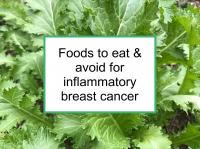Inflammatory breast cancer (IBC), which is characterized by involvement of the skin and lack of a solid tumor mass, accounts for up to 3% of breast cancers. IBC is more likely to be HER2 and EGFR overexpressing than ductal or lobular breast cancer, the most prevalent types. IBC patients tend to be younger than patients with other BC types.
The majority of IBC patients are 40 to 59 years old and they are also somewhat more likely to be African American or pregnant at the time of diagnosis.
Because IBC is so rare, no population studies have investigated the associations between IBC and consumption of specific foods. However, one 2023 study reported that a high fat diet increased tumor growth in a mouse model of IBC. There have also been a few laboratory studies that have demonstrated the impact of food extracts on IBC cells in the laboratory.
IBC patients who are overweight might lower their risk of recurrence by losing weight. Regular exercise has also been found to be associated with lower risk of metastasis of breast cancer, even in the absence of weight loss.
Since very little research on diet exists that specifically mentions inflammatory breast cancer, IBC patients and survivors should also refer to our articles concerning breast cancer subtypes (e.g., ER+/PR+, triple negative, HER2+) for additional information on diet.
Foods that reduce the risk of inflammatory breast cancer
Extracts of the foods listed below have been reported to oppose the growth or progression of inflammatory breast cancer:
The following foods have components that have been shown to inhibit the EGFR receptor. These foods have also been associated with reduced risk of breast cancer in general.
Please read the applicable food webpages when making your own food lists since these pages contain important advice, food rankings (e.g., highly recommended, recommended in moderation), consumption limits, and other pertinent information.
Preliminary evidence suggests that adequate levels of vitamin D are particularly important in inhibiting the metastasis of IBC. Recent research suggests that statins (used to lower cholesterol), can improve progression-free survival in women with inflammatory breast cancer. One 2023 study reported that aspirin use during remission after initial treatment for IBC was associated with significantly improved distant metastasis-free survival and overall survival.
Exposure to bisphenol A should be avoided
Bisphenol A (BPA) has been shown to promote proliferation and resistance to EGFR pathway inhibition in estrogen receptor negative (ER-) IBC cells. BPA that has leached from food packaging and containers is the main source of exposure. For example, BPA is present in canned food and canned soda as a result of leaching from interior epoxy coatings used to prevent corrosion. BPA also migrates into water stored in polycarbonate plastic bottles and some lined reusable metallic water bottles. Please see our article on BPA for more sources of BPA exposure.
Genistein should be avoided
Genistein and soy isoflavone supplements should be avoided by those with IBC. A 2020 study reported that genistein promoted tumor proliferation and increased metastasis in an animal model of IBC. Other abundant sources of soy isoflavones, such as soy protein isolate and soybean paste, should also be limited.
Copper could promote the growth of inflammatory breast cancer
Circulating copper levels have been shown to correlate with tumor incidence and burden. Inducing copper deficiency reduced tumor growth and angiogenesis in a mouse model of IBC. We recommend avoiding the consumption of the following high-copper foods:
Calf's liver contains 12 to 15 mg of copper per 100 g (3.5 oz.), which is well above the recommended dietary allowance (RDA) of 0.9 mg per day. On the other hand, the copper content of chicken liver is about 0.5 mg per 100 g. The foods below contain far less copper than calf's liver, but are potentially significant sources if consumed frequently:
- Basil pesto
- Beef
- Chocolate & cocoa powder
- Flaxseed
- Lentils
- Lima beans
- Nuts, including almonds, Brazil nuts, cashews, hazelnuts, peanuts, pecans, pine nuts, pistachio nuts, walnuts
- Pumpkin seeds
- Sesame seeds
- Shellfish, especially oysters, squid (calamari) & lobster
- Soybeans
- Defatted soy flour products, e.g., soy protein isolate, textured soy protein
- Sun-dried tomatoes
- Sunflower seeds
Most nuts are a significant source of copper. However, walnuts have significant chemopreventive properties and should be consumed in moderation rather than avoided because of their copper content. Note that curcumin, the most biologically active ingredient in turmeric, has been shown to act as a copper chelator.
Unless you are anemic, the U.S. Recommended Dietary Allowance (RDA) for copper of approximately 0.9 mg per day for adults can be used as a guide. It makes sense not to exceed this intake, on average, but not to fall far below it either.
Copper cookware, copper jewelry and jewelry made from copper alloys, such as red, rose or pink gold, are other potential sources of copper exposure. It has been demonstrated that copper bracelets can deliver copper and other minerals through the skin. Soldering or otherwise working with copper or copper alloys can also result in exposure. Living near copper (or gold and copper) mining or smelting operations can result in inhalation of airborne dust containing copper. Note that while outright copper deficiency is rare in the U.S., women with low iron stores are at risk of anemia if they do not have adequate copper intake.
Additional comments
It is important for inflammatory breast cancer patients and survivors to eat a wide variety of the foods on our recommended food list and limit or avoid those on our avoid list, in addition to paying particular attention to the foods above.
Below are links to 20 studies concerning this topic. For a more complete list of studies, please click on the tag IBC.
